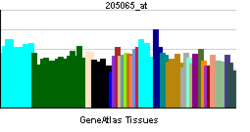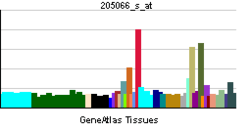Ectonucleotide pyrophosphatase/phosphodiesterase 1
| View/Edit Human | View/Edit Mouse |
Ectonucleotide pyrophosphatase/phosphodiesterase family member 1 is an enzyme that in humans is encoded by the ENPP1 gene.[3][4]
Function
This gene is a member of the ecto-nucleotide pyrophosphatase/phosphodiesterase (ENPP) family. The encoded protein is a type II transmembrane glycoprotein comprising two identical disulfide-bonded subunits. This protein has broad specificity and cleaves a variety of substrates, including phosphodiester bonds of nucleotides and nucleotide sugars and pyrophosphate bonds of nucleotides and nucleotide sugars. This protein may function to hydrolyze nucleoside 5' triphosphates to their corresponding monophosphates and may also hydrolyze diadenosine polyphosphates. Mutations in this gene have been associated with Idiopathic infantile arterial calcification, ossification of the posterior longitudinal ligament of the spine (OPLL), and insulin resistance.[4]
Interactions
Ectonucleotide pyrophosphatase/phosphodiesterase 1 has been shown to interact with Insulin receptor.[5]
References
- ↑ "Human PubMed Reference:".
- ↑ "Mouse PubMed Reference:".
- ↑ Funakoshi I, Kato H, Horie K, Yano T, Hori Y, Kobayashi H, Inoue T, Suzuki H, Fukui S, Tsukahara M (June 1992). "Molecular cloning of cDNAs for human fibroblast nucleotide pyrophosphatase". Arch Biochem Biophys. 295 (1): 180–7. doi:10.1016/0003-9861(92)90504-P. PMID 1315502.
- 1 2 "Entrez Gene: ENPP1 ectonucleotide pyrophosphatase/phosphodiesterase 1".
- ↑ Maddux BA, Goldfine ID (January 2000). "Membrane glycoprotein PC-1 inhibition of insulin receptor function occurs via direct interaction with the receptor alpha-subunit". Diabetes. 49 (1): 13–9. doi:10.2337/diabetes.49.1.13. PMID 10615944.
Further reading
- Abate N, Chandalia M, Di Paola R, Foster DW, Grundy SM, Trischitta V (2007). "Mechanisms of disease: Ectonucleotide pyrophosphatase phosphodiesterase 1 as a 'gatekeeper' of insulin receptors". Nature Clinical Practice Endocrinology & Metabolism. 2 (12): 694–701. doi:10.1038/ncpendmet0367. PMID 17143316.
- Bacci S, De Cosmo S, Prudente S, Trischitta V (2007). "ENPP1 gene, insulin resistance and related clinical outcomes". Current opinion in clinical nutrition and metabolic care. 10 (4): 403–9. doi:10.1097/MCO.0b013e3281e386c9. PMID 17563456.
- Fadini GP, Pauletto P, Avogaro A, Rattazzi M (2007). "The good and the bad in the link between insulin resistance and vascular calcification". Atherosclerosis. 193 (2): 241–4. doi:10.1016/j.atherosclerosis.2007.05.015. PMID 17606264.
- Buckley MF, Loveland KA, McKinstry WJ, Garson OM, Goding JW (1990). "Plasma cell membrane glycoprotein PC-1. cDNA cloning of the human molecule, amino acid sequence, and chromosomal location". J. Biol. Chem. 265 (29): 17506–11. PMID 2211644.
- Belli SI, Mercuri FA, Sali A, Goding JW (1995). "Autophosphorylation of PC-1 (alkaline phosphodiesterase I/nucleotide pyrophosphatase) and analysis of the active site". Eur. J. Biochem. 228 (3): 669–76. doi:10.1111/j.1432-1033.1995.tb20308.x. PMID 7737162.
- Maddux BA, Sbraccia P, Kumakura S, Sasson S, Youngren J, Fisher A, Spencer S, Grupe A, Henzel W, Stewart TA (1995). "Membrane glycoprotein PC-1 and insulin resistance in non-insulin-dependent diabetes mellitus". Nature. 373 (6513): 448–51. doi:10.1038/373448a0. PMID 7830796.
- Belli SI, Goding JW (1995). "Biochemical characterization of human PC-1, an enzyme possessing alkaline phosphodiesterase I and nucleotide pyrophosphatase activities". Eur. J. Biochem. 226 (2): 433–43. doi:10.1111/j.1432-1033.1994.tb20068.x. PMID 8001561.
- Huang R, Rosenbach M, Vaughn R, Provvedini D, Rebbe N, Hickman S, Goding J, Terkeltaub R (1994). "Expression of the murine plasma cell nucleotide pyrophosphohydrolase PC-1 is shared by human liver, bone, and cartilage cells. Regulation of PC-1 expression in osteosarcoma cells by transforming growth factor-beta". J. Clin. Invest. 94 (2): 560–7. doi:10.1172/JCI117370. PMC 296131
 . PMID 8040311.
. PMID 8040311. - Jin-Hua P, Goding JW, Nakamura H, Sano K (1998). "Molecular cloning and chromosomal localization of PD-Ibeta (PDNP3), a new member of the human phosphodiesterase I genes". Genomics. 45 (2): 412–5. doi:10.1006/geno.1997.4949. PMID 9344668.
- Nakamura I, Ikegawa S, Okawa A, Okuda S, Koshizuka Y, Kawaguchi H, Nakamura K, Koyama T, Goto S, Toguchida J, Matsushita M, Ochi T, Takaoka K, Nakamura Y (1999). "Association of the human NPPS gene with ossification of the posterior longitudinal ligament of the spine (OPLL)". Hum. Genet. 104 (6): 492–7. doi:10.1007/s004390050993. PMID 10453738.
- Pizzuti A, Frittitta L, Argiolas A, Baratta R, Goldfine ID, Bozzali M, Ercolino T, Scarlato G, Iacoviello L, Vigneri R, Tassi V, Trischitta V (1999). "A polymorphism (K121Q) of the human glycoprotein PC-1 gene coding region is strongly associated with insulin resistance". Diabetes. 48 (9): 1881–4. doi:10.2337/diabetes.48.9.1881. PMID 10480624.
- Andoh K, Piao JH, Terashima K, Nakamura H, Sano K (1999). "Genomic structure and promoter analysis of the ecto-phosphodiesterase I gene (PDNP3) expressed in glial cells". Biochim. Biophys. Acta. 1446 (3): 213–24. doi:10.1016/s0167-4781(99)00090-1. PMID 10524196.
- Maddux BA, Goldfine ID (2000). "Membrane glycoprotein PC-1 inhibition of insulin receptor function occurs via direct interaction with the receptor alpha-subunit". Diabetes. 49 (1): 13–9. doi:10.2337/diabetes.49.1.13. PMID 10615944.
- Rutsch F, Vaingankar S, Johnson K, Goldfine I, Maddux B, Schauerte P, Kalhoff H, Sano K, Boisvert WA, Superti-Furga A, Terkeltaub R (2001). "PC-1 nucleoside triphosphate pyrophosphohydrolase deficiency in idiopathic infantile arterial calcification". Am. J. Pathol. 158 (2): 543–54. doi:10.1016/S0002-9440(10)63996-X. PMC 1850320
 . PMID 11159191.
. PMID 11159191. - Frittitta L, Baratta R, Spampinato D, Di Paola R, Pizzuti A, Vigneri R, Trischitta V (2001). "The Q121 PC-1 variant and obesity have additive and independent effects in causing insulin resistance". J. Clin. Endocrinol. Metab. 86 (12): 5888–91. doi:10.1210/jc.86.12.5888. PMID 11739459.
- Koshizuka Y, Kawaguchi H, Ogata N, Ikeda T, Mabuchi A, Seichi A, Nakamura Y, Nakamura K, Ikegawa S (2002). "Nucleotide pyrophosphatase gene polymorphism associated with ossification of the posterior longitudinal ligament of the spine". J. Bone Miner. Res. 17 (1): 138–44. doi:10.1359/jbmr.2002.17.1.138. PMID 11771660.
- de Azevedo MJ, Dalmáz CA, Caramori ML, Pecis M, Esteves JF, Maia AL, Gross JL (2003). "ACE and PC-1 gene polymorphisms in normoalbuminuric Type 1 diabetic patients: a 10-year prospective study". J. Diabetes Complicat. 16 (4): 255–62. PMID 12126783.
- De Cosmo S, Miscio G, Zucaro L, Margaglione M, Argiolas A, Thomas S, Piras G, Trevisan R, Perin PC, Bacci S, Frittitta L, Pizzuti A, Tassi V, Di Minno G, Viberti G, Trischitta V (2003). "The role of PC-1 and ACE genes in diabetic nephropathy in type 1 diabetic patients: evidence for a polygenic control of kidney disease progression". Nephrol. Dial. Transplant. 17 (8): 1402–7. doi:10.1093/ndt/17.8.1402. PMID 12147786.
- Jacobsen P, Grarup N, Tarnow L, Parving HH, Pedersen O (2003). "PC-1 amino acid variant (K121Q) has no impact on progression of diabetic nephropathy in type 1 diabetic patients". Nephrol. Dial. Transplant. 17 (8): 1408–12. doi:10.1093/ndt/17.8.1408. PMID 12147787.


